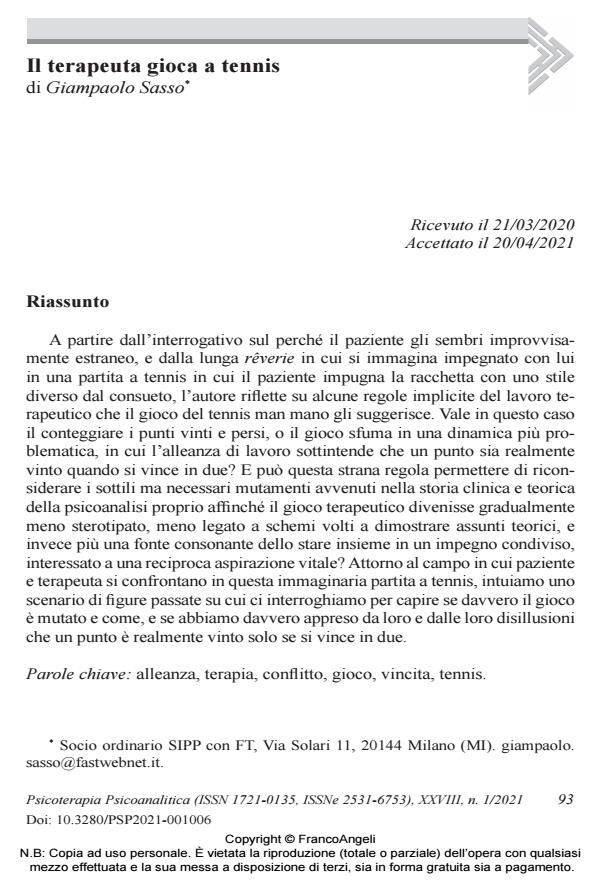The therapist plays tennis
Journal title PSICOTERAPIA PSICOANALITICA
Author/s Giampaolo Sasso
Publishing Year 2021 Issue 2021/1 Language Italian
Pages 15 P. 93-107 File size 154 KB
DOI 10.3280/PSP2021-001006
DOI is like a bar code for intellectual property: to have more infomation
click here
Below, you can see the article first page
If you want to buy this article in PDF format, you can do it, following the instructions to buy download credits

FrancoAngeli is member of Publishers International Linking Association, Inc (PILA), a not-for-profit association which run the CrossRef service enabling links to and from online scholarly content.
Starting from the question about why the patient suddenly seems alien to him, and from the long rêverie in which he imagines himself engaged with him in a tennis match in which the patient holds the racket with a different style than usual, the author reflects on some implicit rules of the therapeutic work that the game of tennis gradually suggests to him. In this case, is it worth counting the points won and lost, or does the game fade into a more problematic dynamic, in which the working alliance implies that a point is really won when the two people win? And can this strange rule allow us to reconsider the subtle but necessary changes that have occurred in the clinical and theoretical history of psychoanalysis precisely so that the therapeutic game would gradually become less sterotyped, less tied to schemes aimed at demonstrating theoretical assumptions, and instead more a consonant source of being together in a shared commitment, interested in a reciprocal vital aspiration? Around the field in which patient and therapist confront each other in this imaginary tennis match, we intuit a scenario of past figures on which we question ourselves to understand if the game has really changed and how, and if we have really learned from them and their disillusions that a point is only really won if two win together.
Keywords: alliance, therapy, conflict, play, win, tennis
- Ambrosiano L., Gaburri E. (2008). La spinta a esistere. Note cliniche sulla sessualità oggi. Roma: Borla.
- Baricco A. (1994). Novecento. Milano: Feltrinelli.
- Calvino I. (1995). Meiosi. In: Ti con zero. Milano: Mondadori.
- Chasseguet-Smirgel J. (1987). Creatività e perversione. Milano: Raffaello Cortina.
- Freud S. (1895). Progetto di una psicologia. OSF, 2.
- Freud S. (1920). Al di là del principio di piacere. OSF, 9.
- Freud S. (1927). Feticismo. OSF, 10.
- Freud S. (1938). La scissione dell’Io nel processo di difesa. OSF, 11.
- Grunberger B. (1996). Il narcisismo. Milano: Einaudi.
- Kernberg O. (1993). Aggressività, disturbi della personalità e perversioni. Milano: Raffaello Cortina.
- Khan M. (1982). Le figure della perversione. Torino: Bollati Boringhieri.
- Masciangelo P. (1989). Aspetti, funzionamenti e relazioni perverse. Metapsicologia di un’esperienza clinica. In: Semi A. (a cura di). Trattato di psicoanalisi vol. II. Milano: Raffaello Cortina, 305-343.
- Mc Dougall J. (1990). Teatri del corpo, Milano: Raffaello Cortina. Racamier P.C. (1992). Il genio delle origini. Psicoanalisi e psicosi. Milano: Raffaello Cortina, 1993.
- Scalzone F. (a cura di) (2009). Perversione, perversioni e perversi. Roma: Borla.
- Stoller R.J. (1978). Perversioni. La forma erotica dell’odio. Milano: Feltrinelli.
- Thanopulos S. (2009). La centralità del masochismo nella perversione. In: Scalzone
- F. (a cura di). Perversione, Perversioni e Perversi. Roma: Borla.
- Winnicott D.W. (1965). Sviluppo affettivo e ambiente. Roma: Armando, 1972.
- Winnicott D.W. (1974). Gioco e realtà. Roma: Armando, 2003.
Giampaolo Sasso, Il terapeuta gioca a tennis in "PSICOTERAPIA PSICOANALITICA" 1/2021, pp 93-107, DOI: 10.3280/PSP2021-001006